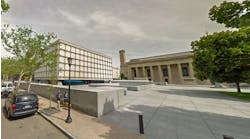The Los Angeles Unified School District has made significant progress in reversing zero-tolerance disciplinary policies, but still needs to correct practices that have created a school-to-prison pipeline for many African-American and Latino students.
That is the conclusion of a study issued by a community action group in Los Angeles. “Brown, Black and Over-Policed in L.A. Schools,” a report from the Community Rights Campaign of the Labor/Community Strategy Center, found that black and Latino students in the Los Angeles district are ticketed or arrested in disproportionate numbers for school-related offenses.
“We call upon the school district, city council, mayor and law enforcement agencies to take immediate action to reverse the continuing violations of students’ civil and human rights that are having devastating implications for our communities’ overall health and prosperity,” the report says.
An encouraging sign in ending the school-to-prison pipeline, the campaign says, is the sizable drop in the number of tickets issued to students. School police ticketing was down 54.8 percent from 2011-12 to 2012-13; truancy and tardy tickets are down by 80 percent.
“Police had been sweeping up and ticketing more than 10,000 public school students every year…for being absent or late to school,” the report says.
Most of those ticketed could not afford to pay their fines, not to mention the additional court fees, and the missed days of work to attend the required court hearings, the report asserts.
“By systematically enabling and encouraging punitive ticketing at school, this curfew law had been a literal gateway to juvenile court, and in some cases even juvenile detention, for many of our youth,” the report says.
Although the district has eased off ticketing, those who are ticketed or arrested are likely to be black or Latino. A Latino student was twice as likely to be ticketed or arrested as a white student, and a black student was nearly six times as likely as a white student to be ticketed or arrested at school.
“Statistics like these raise the question of whether it has become social policy to criminalize black and Latino youth for behaviors that are considered normal and acceptable for white students,” the report says.
The report says the reliance on police involvement affects not just the students ticketed or arrested, but also the entire school environment.
“Widespread use of arrests and tickets dramatically changes the culture of schools, leading to greater antagonism and distrust between students and staff,” it states. “In fact, these practices have turned many Los Angeles schools into unwelcoming and even hostile environments….Instead of…a safe and supportive environment in which to learn, grow, become more self-aware, find self-expression and deal with questions of identity and social belonging, the school becomes a hostile institution where they feel treated as inherently guilty, suspect, or deficient.”
The campaign recommends several changes for the Los Angeles district to consider:
- Cease ticketing and arrests for student conduct in the following areas: disturbance or disruption; truancy; trespass; loitering; profanity; insubordination or noncompliance with school rules; vandalism, graffiti or possession of implements of graffiti; fighting or physical conduct not involving serious bodily harm; verbal disruption or aggression; petty theft; possessing tobacco or a lighter; possessing or using any controlled substance or alcoholic beverage that does not mandate suspension or expulsion.
- Stop ticketing and arrests of elementary and middle school students.
- Ensure civil rights remedies at schools where tickets and arrests demonstrate racial inequities.
- Clearly define and limit the role of police on campus.
- Instead of directing federal funding for law enforcement at schools, allocate funds for counselors and youth intervention workers.
- Establish restorative justice programs and School-Wide Positive Behavior Interventions and Supports in all schools.
View the entire 51-page report (PDF file).

